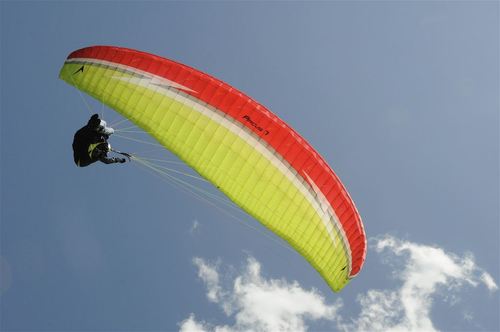Swing Arcus 7.26 |
|||||||||||||||||||||||||||||||||||||||||||||||||||||||||||||||||||||||||||||||||||||||||||||||||||||||||||||||||||


|
|||||||||||||||||||||||||||||||||||||||||||||||||||||||||||||||||||||||||||||||||||||||||||||||||||||||||||||||||||
Instability rating |
|||||||||||||||||||||||||||||||||||||||||||||||||||||||||||||||||||||||||||||||||||||||||||||||||||||||||||||||||||
|
|||||||||||||||||||||||||||||||||||||||||||||||||||||||||||||||||||||||||||||||||||||||||||||||||||||||||||||||||||
Glider characteristics |
|||||||||||||||||||||||||||||||||||||||||||||||||||||||||||||||||||||||||||||||||||||||||||||||||||||||||||||||||||
|
Launch preparations: average
launch characteristics: balanced, delayed climb, needs gentle guidance, good feedback during inflation, no braking required, slows before zenith, control check simple, low takeoff speed
asymmetric collapse: moderate dynamics, total course change 90-180°, (1), moderate course change rate, moderate forward pitching 45-60°, (2), moderate height loss 30-39 m, (2), moderate sink velocity 15-19 m/s, (2), G-Force < 2,5 G, (1)
Frontal collapse: marked pitch backwards 45-60°, moderate pitch forwards 30-45°, moderate dynamics, no course change, (1), immediate automatic recovery, symmetric recovery, delayed return to normal airspeed, delayed reinflation of wingtips, moderate height loss 30-39 m, (2), low sink velocity 10-14 m/s, (1)
Spiral dives: rapid sink velocity increase, Moderate G-Force 3,5- 4.0 G, (2), Sink velocity after 720° <18 m/s, (3), Very high maximum sink velocity <25 m/s, (4), sink velocity increase < 6 m/s on brake release, (2), Course change 540-720° after spiral exit, (4), moderate height loss during recovery 30-60 m, (2)
B-Stall: normal force required, moderate pitch backwards 15-30°, moderate pitch forwards 15-30°, stable sink phase, no tendency to deform, immediate return to normal airspeed, 6-8 m/s, height loss on recovery < 20 m
big ears: simple initiation, stable flight phase, delayed automatic recovery, Vsink unaccelerated 2,5-3 m/s, Vsink accelerated 3,5-4 m/s, Vunaccelerated 3-5 km/h less than trimspeed, Vaccelerated 5-8 km/h faster than trimspeed |
|||||||||||||||||||||||||||||||||||||||||||||||||||||||||||||||||||||||||||||||||||||||||||||||||||||||||||||||||||
Notes |
|||||||||||||||||||||||||||||||||||||||||||||||||||||||||||||||||||||||||||||||||||||||||||||||||||||||||||||||||||
|
Launch Characteristic: Independences Pioneer is a little more dynamic, this canopy climbs faster and requires more brake appliance to stabilise. Low end B gliders from Swing and Air Design behave very similarly. During inflation these gliders need to be guided a little, but do not hang behind orovershoot at all. Asymmetric Collapse: Relatively moderate reactions, moderate dynamics, height loss < 40m Front Collapse: Swings Arcus 7 stands out from the others that its height loss on large collapses does not differ significantly from smaller ones. The reason for this: on smaller collapses the canopy ears tend to stay closed which delays recovery to normal flight. On larger collapses recovery is usually immediate. Spiral Dive: The spiral test provided no great surprises. All gliders behaved in accordance with their LTF classifications. Swings Arcus 7 tends to remain longer in the spiral when recovering from fast spirals before going nose up and self-exiting. Due to this the height loss was the greatest under the tested gliders. B-Stall: The low end LTF-B Swing Arcus 7 displayed good behaviour in B-stalls. No deformation tendencies, stable sink phase with good sink rates and no recovery or deep stall problems on exiting. Big Ears: Performing big ears on all of the tested gliders was unproblematic. Icaros Cyber TE tends to flap its ears and snake a little in straight flight at full speed. This behaviour is note noted at trim speed. |
|||||||||||||||||||||||||||||||||||||||||||||||||||||||||||||||||||||||||||||||||||||||||||||||||||||||||||||||||||
Rating |
|||||||||||||||||||||||||||||||||||||||||||||||||||||||||||||||||||||||||||||||||||||||||||||||||||||||||||||||||||
|
Safety class 4 This class of paraglider reacts demandingly to one or more of the following manoeuvres: frontal collapse, asymmetric collapse or spiral dive.Demandingly means that the above manoeuvres result in marked dynamic reactions from the glider and/or large height losses. Advanced piloting skills which need to be regularly practised, together with good personal reaction times are required to safely fly this class of gliders. Basic recovery techniques for ending a manoeuvre are not sufficient to maintain control, reduce height loss to a minimum and prevent subsequent critical reactions. Pilots should be able to recognise the onset of the above manoeuvres and be able to prevent or minimise their effects through immediate and precise pilot inputs. Additional experience such as regular ground handling and SIV training is required to safely fly gliders of this class. Special training or pilot skills which exceed standard training may be required for the safe performance of emergency descent techniques. Gliders of this Safety Class are not suitable for beginners, irregular flyers or low-airtime pilots. |
|||||||||||||||||||||||||||||||||||||||||||||||||||||||||||||||||||||||||||||||||||||||||||||||||||||||||||||||||||

